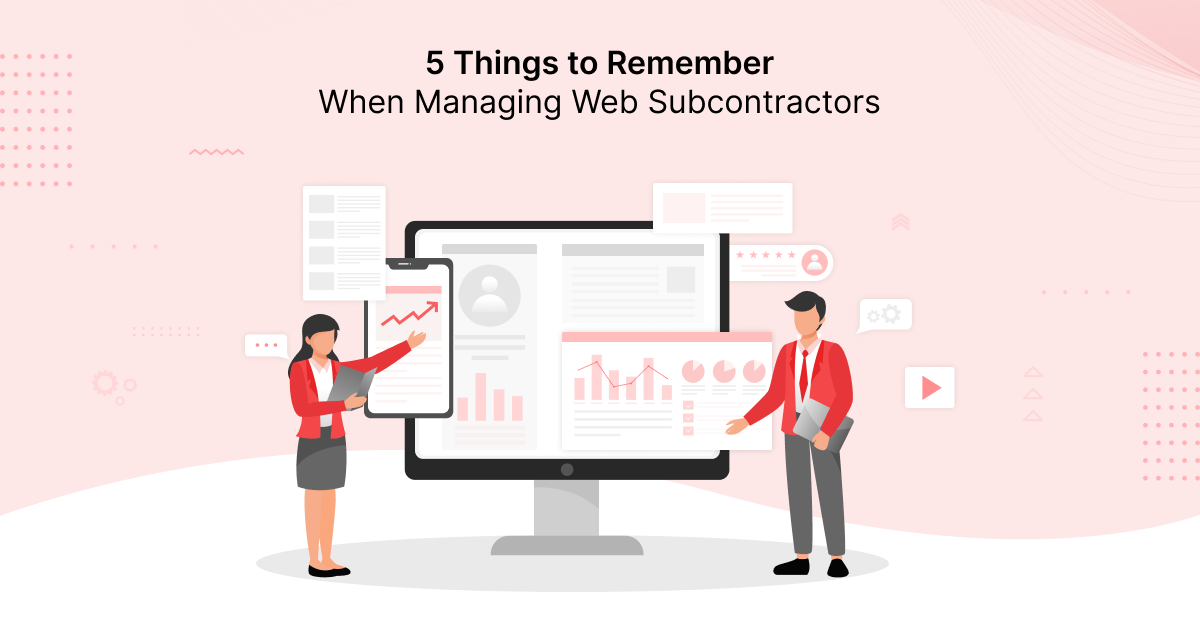
There are plenty of reasons to hire a web subcontractor:
Maybe your web agency is overwhelmed with work, and clients just keep piling it on.
Maybe a client is asking for skills or expertise you don’t exactly have.
Maybe you just don’t have an economically feasible way to complete a certain task by its deadline.
Whatever the case is, hiring a web subcontractor is an efficient way to get these kinds of jobs done. It gives you scalable access to project-specific skills, hugely increasing your workload capabilities without significantly raising costs.
But hiring white label web services is not without its risks. In order to accomplish your goals reliably and securely, you need to use the right approach.
Preparing Yourself for Managing Web Contractors
If you wait for a client to make a challenging request and then start rushing to find a white-label service provider, you run the risk of making mistakes.
On a similar note, if you look for the cheapest possible subcontractors, neglect to pre-qualify your hires, and let management responsibility slip out of your hands, you’re likely to end up with a shoddy project that needs re-doing – and you’re on the hook to pay for it.
But there are ways to prepare yourself for managing web subcontractors in a way that makes it easy to gain access to a potentially unlimited on-demand workforce.
Develop your subcontracting approach around the following five tips to make sure you have the best system in place for managing subcontracting work effectively.
1. Establish a Comprehensive Agreement
The contract you sign with your white label service provider should cover the roles and responsibilities of every party to the contract. If changes or alterations occur during the course of your negotiations, make sure they are represented in the contract.
A comprehensive contract is of critical value since any discrepancy between your expectations and the final result will be compared to its terms. The clearer and more concise the contract is, the less likely disagreements are to arise.
Be sure to add clauses on the following subjects:
- Responsibilities. Which team members are responsible for meeting the goals of your agreement? Delegate responsibilities to individuals whenever possible.
- Quality. Who has the final say on quality? What happens if the deliverable does not meet those quality standards?
- Payments and Deadlines. It should go without saying that payments and deadlines be included in the contract, but make sure there are no expectations left unsaid, such as when and how payment will occur, and under what conditions – for instance, what happens if you clear the deliverable but your client doesn’t like it?
2. Be Clear and Communicative
In a perfect world, you could find a good subcontractor, sign a contract, give them the materials, and get a great finished product in return. In the real world, it takes constant, clear communication to get this done – and communication is hard.
The best way to approach communication is systematic. To paraphrase Ludwig Wittgenstein, one of the 20th century’s most important philosophers of communication and language, focus on atomic facts rather than broad generalizations.
For instance: “I want a great-looking website” is a much harder statement to understand than, “I want an illustration-heavy website designed using a broken grid layout, in luxurious white and gold colors.”
You shouldn’t just communicate clearly, but also frequently. Hold meetings, verify milestones, and engage with your subcontractor so you know how things are going.
3. Talk about Pricing Beforehand
People don’t always feel comfortable talking about price. You may feel pressure to come up with a price that will sufficiently motivate your subcontractor while still producing profit on your end.
Price negotiations can be tense, but as long as you don’t lose you’re cool you are well-suited to reach a mutually beneficial agreement. Identify your preferred position and work towards a compromise from there.
One of the main pricing issues that web agency owners deal with when hiring a web subcontractor is choosing between fixed pricing and hourly pricing:
- Fixed pricing works best when the scope of a project is subject to change. You can be sure that the project doesn’t get too expensive, even if you have additional needs.
- Hourly pricing works best when you are very sure about the scope of your project. It is also a good idea for long-term projects involving multiple milestones, multiple clients, or multiple types of work.
For web agency owners, this means that fixed pricing is the best way to start all but the biggest projects. If you’re hiring white label web services for the first time, you’ll want the assurance, reliability, and simplified budgeting that fixed pricing offers
4. Plan for Problems and Identify Them When They Occur
Not every project is going to go perfectly. The key to successfully managing web subcontractors is to plan ahead for potential problems and to identify them when they occur.
When identifying problems, an important step is determining what the problem’s cause is. Ask yourself if they happen due to:
- Unreasonable customer expectations?
- Poor management on the subcontractor’s behalf?
- Poor communication on your behalf?
It’s important not to use this line of thought to place blame on one party or another. It just gives you the information you need to rectify the problem and move forward.
If you fail to take this step, you could find yourself in a vulnerable position. For instance, withholding cash payment to a subcontractor in breach of your own contract terms.
5. Know Your Subcontractor, Earn a Partner
Ideally, you should find and approach your preferred subcontractor before you actually need services performed. This gives you time to work out all of these details and create a stable foundation for working together before client deadlines loom.
That approach makes the difference between a generic subcontractor and a bona fide partner you can rely on whenever you need access to a scalable workforce.
If you wait until you have a client breathing down your neck and a deadline coming up, you’re going to have a very hard time establishing a functional working partnership in time.
It’s so much easier when you already know how your partner works, how committed your partners’ employees are, what resources they have available, and what project management software tools they use.
It’s Best to Start Early
Working with subcontractors often sounds scarier than it really is. A few horror stories can make it seem like the whole process is fraught with risk – but there are effective ways to mitigate those risks.
To recap:
- Put together a comprehensive plan for project discovery, handover, and agreement.
- Communicate your expectations clearly.
- Determine what the ideal pricing structure is for you.
- Plan ahead for potential problems.
- Know your subcontracting partners.
Starting early and making connections with potential white label agencies before the clock is ticking is the best way to be prepared for high-volume work orders. Finding a reliable subcontracting partner and developing a long-term relationship is the key to success.
